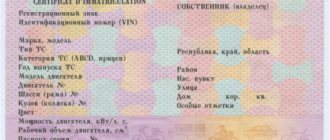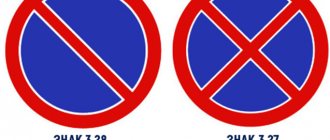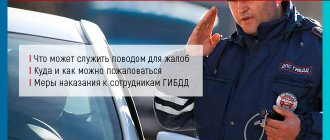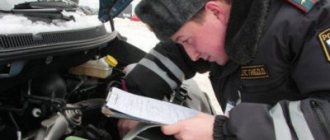Limitation of registration actions - what are we talking about?
Most often, this type of punishment is imposed on a car as an increase in penalties.
If a fine for a traffic violation is not paid on time, the car is “tied” to the owner until the latter pays off the debt.
This preventive measure can also be applied when the car owner has arrears in alimony, rent, taxes, administrative offenses, customs disputes, and legal proceedings.
A ban is issued by the road traffic inspectorate, but it is requested by the body interested in this - customs, court, police, and so on.
Who has the authority to lift the ban?
It was mentioned just above that any government agency that has the authority and grounds can impose a ban on vehicle registration. Before lifting the restriction, you should check whether there are any fines or even lawsuits against the violator. To do this, go to the same traffic police website (listed in the previous section) and enter the vehicle identifier (VIN code, body or chassis number).
Then select Check for restrictions.
Make sure the type of restriction matches your request.
Just above you can see who issued the ban. This is very important information, since the removal of restrictions on registration actions with a car must be carried out by the same authority.
If you are not confident in using the Internet, it is better to go to the nearest traffic police department. There you will receive all the necessary information.
How to remove the seizure of a car by bailiffs
Every year there are buyers who, when contacting the traffic police, are refused due to the fact that the car has a registration ban. What to do in this case: 1. If the seller is decent, then resolving the issue will not be difficult.
Attention
You just need to contact him (call) and explain the situation. a) If the debt is small and the seller simply did not know about it, then he will be able to pay off the debt. After this, the seller needs to contact the bailiffs to remove the restriction.
b) If the debt is large and the seller cannot pay it off, then he will return the money you paid for the car and take the car back. 2. The situation is more complicated if the seller is not decent. In this case, it is impossible to quickly solve the problem and you have to go to court so that the judge declares the purchase and sale transaction invalid and obliges the seller to return the money.
It is important to meet one of the conditions. These are the grounds on which an arrest can be lifted.
The Resolution on the completion of enforcement proceedings indicates information about the cancellation of the seizure of the vehicle. Procedure for lifting the arrest To remove the arrest, the owner of the car must make a request by filling out a sample statement of claim to remove the arrest from the car in the traffic police, indicating all registration information. Grounds for lifting the arrest:
The decision to complete the proceedings must contain information about the cancellation of the seizure of the vehicle. The bailiff service makes a decision to release the vehicle from arrest on the same day when it receives information that there are sufficient grounds to cancel the arrest.
In addition to the fact that the owner can challenge the seizure, he is also given the right to challenge. The answer to the question - is it possible to challenge the ban on registration actions and in what cases is given in the law of the Russian Federation “On Enforcement Proceedings”, as well as in procedural legislation. Contestation can occur in various ways.
The main requirement for the implementation of such actions is movement through the authorities. This means that before turning to the court authorities, it is necessary to try to resolve the conflict within the framework of the FSSP. In the event that the bailiff made an unlawful decision, it is necessary to file an appeal to his immediate supervisor. The application is made in writing and presented in free form.
Only after completing all the above actions, the owner of the vehicle has the right to file a statement of claim and send it to the court.
A claim to challenge an illegally imposed arrest must contain:
- The name of the judicial authority, its address and zip code.
- Full name of the citizen submitting the application.
- Description of the problem situation and reference to legal acts, as well as decisions of other bodies.
- Petition to the court.
- List of documents provided to the judicial authority.
As a rule, consideration of cases of this kind is carried out within a period not exceeding one month. A court decision will be the basis for removing all restrictions imposed on a citizen’s car.
When buying a car, citizens wonder how and where to find information about imposing a ban. First of all, a person has the right to apply to the FSSP department. Upon his request, all necessary information will be provided. To speed up this process, it has become possible to check the car on the website of the above authority. As a rule, this action takes no more than five minutes.
We invite you to read: How to collect a debt by court decision
Thus, seizure of a car is a measure used to preserve property and prevent its alienation. The arrest is imposed according to the rules provided for by the legislation of the Russian Federation. Decisions of authorized bodies can be appealed, and if there are grounds, all encumbrances can be completely removed.
- Receipt by the bailiff of a writ of execution, a fine or other document requiring the taking of measures to collect a debt or transfer the car into the hands of a third party.
- Initiating enforcement proceedings and informing the debtor of the due date for voluntary payment of the debt or performance of other actions specified in the court decision.
- Beginning of forced collection: search for property, search for funds in accounts;
- Drawing up an inventory report of the vehicle at its location, where all relevant information is indicated: vehicle make and model, year of manufacture, VIN numbers, chassis and body, grounds for restrictions and their types, responsible persons, etc.
- Distribution of the act to the parties to the case, as well as to the traffic police and notary authorities.
- The seizure is lifted after the debt is repaid or the car is sold to fulfill a court decision.
In addition to the arrest imposed by the bailiff on the basis of a court decision that has entered into legal force and the subsequent writ of execution, there are other reasons for restricting the disposal and use of a car:
- Based on Art. 77 of the Tax Code of the Russian Federation No. 146-FZ of July 31, 1998, property can be seized in order to collect taxes, penalties and fines.
- Based on Art. 156 of Law No. 311-FZ of November 27, 2010, the customs authority represented by the head may apply seizure of property as security for the payment of customs duties.
- In accordance with Art. 115 of the Code of Criminal Procedure of the Russian Federation, arrest is applicable to ensure compliance with the requirements set out in the court verdict.
Debt to tax and customs authorities is resolved in a fairly obvious way - by paying the corresponding debt for taxes and customs duties and then providing documentary evidence of this. Solving the problem with the restriction imposed by the bailiff service will require more patience and understanding from the motorist of the legal mechanisms of our state.
1It is possible to remove a seizure from a car imposed by a court only if it is determined who exactly (which official structure, executor) introduced these restrictive measures.
People are often concerned about the following question: how to find out who seized a car? Where can I find out whether a vehicle is free from restrictions or whether it is under arrest?
The required information block is located on the main page of the site. It is on the right, with the inscription “Online services of the traffic police”.
1Under the block on a blue background there is a “Vehicle check” button. It must be pressed.
2You will be redirected to a page with a verification request form. There you must indicate the VIN number of the car, body number or engine number.
3Then the security code is entered. It is indicated in the picture below the main window.
4Then you should click the green button that says “Check for restrictions.” After these manipulations, a page with the information you are interested in will appear.
There is no information about the cars that are pledged here. A check is underway to determine the fact of the arrest.
People contact our company with the question: they bought a car, but it was seized. What to do now? How to remove a car from a seizure imposed by bailiffs?
Upon application, this restriction will be lifted if it was imposed after the conclusion of the purchase and sale agreement. Then you need to contact the bailiffs with a written statement, in which you need to ask to lift the restriction. This application must be accompanied by a car purchase and sale agreement (certified copy).
If the bailiffs do not lift the ban voluntarily, you should file a lawsuit to release the property from seizure.
When restrictions are imposed before the purchase and sale agreement is concluded, you need to file a lawsuit to declare the transaction invalid. Then the person has the right to demand a refund for the purchased car.
- if it is necessary to ensure the safety of property belonging to the transfer to the claimant or sale;
- when executing a judicial act that stipulates the obligation to confiscate property;
- when executing a judicial act stating that the property that belongs to the debtor should be seized.
- Based on the documentation package provided, the bailiffs make a decision. Usually, this happens the next day after the applicant applies.
- If the decision is positive, the bailiffs report it to all authorities where the arrest was imposed and to the debtor himself.
- Often, information does not reach the inspection immediately. To speed up the procedure, the car owner can take the resolution and take it to the state traffic inspectorate in person.
A system of complete electronic document management has been established between the FSSP and various banks, that is, all requests, procedural documents and responses are sent by them via the Internet. So, to locate the debtor’s accounts, they carry out a search. Requests are sent to tax authorities and various financial organizations.
In fact, almost anyone can find themselves in such a situation today, or many have already encountered such a situation as the seizure of a salary card by bailiffs. What should the debtor do in this case? First of all, if you have a debt, you need to pay it off as quickly as possible so that the bailiffs do not deduct part of your earnings.
- To dispose of property. This ban is precisely a ban on registration actions. In any case, it is included in the concept of arrest. Those. if a car is seized, it cannot be sold, donated, etc.
- For the right to use property. This ban is issued if necessary, i.e. not always. It means that the car cannot be driven.
Procedure for lifting the ban
To remove the ban on registering a car with the traffic police, you must perform the following sequence of actions:
- Find out the reason for the ban. This can be done by submitting a request to the traffic police or the authority that imposed the restriction.
- Eliminate the reason for the punishment. Most often this is a fine that just needs to be paid. But there may be more serious reasons - for example, non-compliance with the Euro-5 standard or the presence of unauthorized changes in the design of the car.
- Submit a statement indicating that you have corrected the situation.
But what to do if the ban was imposed without reason? Then you need to challenge the decision in court.
How to challenge a restriction
First of all, you need to check the date the ban was issued. If more than ten days have passed since this moment, then, in addition to a statement about the unfairness of the sanction, you will have to write an explanatory note as to why you did not challenge the decision within the prescribed period.
You can challenge a sanction not only because it is unfair, but also when you did not receive a copy of the decision (in hand or by mail). In any case, you should not count on a quick lifting of the ban.
Then you need to write statements to the court and the bailiff department. In the latter, inform that you intend to challenge the sanction in court and demand that the appeal period be restored. If the court rules in your favor, the restriction will be lifted.
Seizure of a car: legislative framework
Bailiffs impose an arrest based on a court decision to seize a car due to the car owner’s failure to fulfill financial obligations (debt on alimony payments, bank loans, failure to pay fines, taxes, utility bills, etc.) The arrest is made exclusively by court decision.
In accordance with Part 2 of Art. 85 “On Enforcement Proceedings”, the bailiff is obliged to engage an appraiser for valuation within one month from the date of discovery of the debtor’s property.
The assessment is carried out from a week to a month, then, in accordance with Part 4 of the same article, the bailiff makes a decision on the assessment of a thing or property right no later than three days from the date of receipt of the appraiser's report, then in accordance with Part 7 of Art. 87 of the Law.
The transfer of the debtor's property to a specialized organization for sale is carried out by a bailiff under an acceptance certificate within ten days from the date of assessment of the debtor's property. When deadlines are violated, the collector has every right to appeal the actions (inactions) of the bailiffs in the order of subordination, or to challenge them in court. Let's find out how to remove a court-imposed seizure from a car.
What are the deadlines for lifting the arrest? The FSSP must make a decision to release the vehicle from arrest immediately on the same day following receipt of the information. The seizure of a vehicle is a preventive measure that prohibits registration of the vehicle until the owner executes a court decision or until existing violations are eliminated.
Let's find out some important points related to the process of seizing a car. We will also learn how to remove a seizure from a car if the seizure was imposed by bailiffs.
Important
Procedure and procedural documents In accordance with the legislation in force today, the rules for imposing and removing the seizure of a car by the bailiff service are recorded in the Federal Law of the Russian Federation “On Enforcement Proceedings”. So, you found out that your car is under arrest, but you do not agree with the decision made by the bailiff.
After such a visit, you will already know with confidence the answer to the question of whether this arrest is legal or not.
The degree and specificity of the restrictions are determined by the court, and the bailiff only carries out the will of the judicial authority. If it is necessary to prevent the possible sale of property, arrest is imposed in terms of transactions (sale, donation) of the vehicle.
Info
If the main goal is the physical preservation of property and protecting it from intentional or accidental damage, then the court indicates a ban on use and the actual transfer of the car for safekeeping. The following key stages of imposing restrictions on a vehicle can be distinguished:
- Making a decision/ruling on arrest by the court.
The court decision is made based on the results of consideration of the civil case, and the ruling on interim measures is made on the day the court receives the claim and accepts it for its proceedings.
- Preparation and submission of a writ of execution for the seizure of a vehicle.
The most difficult situation is that you bought a car, the seizure of which was imposed long before the purchase and sale agreement was concluded. The best option here would be to contact an experienced lawyer who has encountered this situation more than once and has information not only of a theoretical nature.
Of course, it would be ideal to demand in court not the removal of the arrest, but the termination of the car purchase and sale agreement. It is impossible to lift the arrest in this case, unless, of course, its former owner pays his debts and fulfills his obligations under the writ of execution.
Almost always, the court takes the side of the deceived buyer and terminates the transaction, since the “unscrupulous” former owner, knowing about the restrictions imposed on him by the bailiff or other authority, and the inability to dispose of the car, still violated the law.
Seizure of a car: legislative framework Bailiffs seize a car based on a court decision to seize a car due to the car owner’s failure to fulfill financial obligations (debt on alimony payments, bank loans, non-payment of fines, taxes, utility bills, etc.).
In accordance with Part 2 of Art. 85 “On Enforcement Proceedings”, the bailiff is obliged to engage an appraiser for valuation within one month from the date of discovery of the debtor’s property.
Consequences of seizure Depending on the restrictions established, the following consequences may occur for the owner of the vehicle or the person using it:
- Inability to sell, lease or donate a car;
- Impossibility of full operation if the use of the vehicle is prohibited;
- The risk of being detained if the use of a car is prohibited, but it continues to be used or is wanted.
- The risk of forced sale of vehicles to pay off the debt if the debt is not resolved by other means.
We invite you to read: Compensation for moral damage in civil law: Articles 151 and 1100 of the Civil Code of the Russian Federation, judicial practice of recovery under the law on the protection of consumer rights
If a car is impounded, is it possible to drive it without breaking the law? There are often situations when the owner sells his car and the documents have already been prepared, but problems arise when completing the transaction. As a rule, the reason for termination of the transaction is that the car has been seized by bailiffs.
However, there are exceptions. Usually they consist in the fact that the seizure is not imposed on the property, but on the restriction in registration actions. This means that the owner himself can drive the car, but he cannot sell it or register it in the name of another person.
The imposition of a ban on registration actions means a restriction of the right to register a car with the traffic police. As a result, the actual sale of the vehicle is not permitted. The question of whether it is possible to operate a car while under arrest is resolved by the legislation of the Russian Federation on enforcement proceedings.
The procedure for seizing a car by bailiffs consists of the following steps:
- Filing an application for the execution of these actions by the claimant.
- Consideration of the petition by bailiffs and making a decision on it.
- Imposition of a ban on registration.
In addition to the ban on registering a car, a car can be completely removed from a citizen’s possession in order to ensure its safety. This type of encumbrance is used quite often.
The statute of limitations for prohibiting vehicle registration is not established by law. The process of removing the encumbrance is associated only with the decision of the authorized body, the end of the proceedings, or the court’s rendering of a decision on a controversial legal relationship.
The reasons for the ban on vehicle registration are a set of conditions, the presence of which limits are established.
- Failure to pay legally established tax amounts.
- Importation of an unregistered object into the territory of the Russian Federation.
- Ensuring the execution of decisions of courts of various instances.
- Ensuring the preservation of the thing that needs to be transferred to the claimant or that is the subject of a dispute.
These are not all cases where a citizen’s rights to property are limited. Depending on the type of object, other cases may be provided.
find_in_page Related Articles
(click to open)
Read additionally: how a car is checked for arrests and restrictions.
Free legal consultation
Free legal consultation
We will answer your question in 5 minutes!
Ask a Question
We will answer your question in 5 minutes!
When deciding whether a donated car is seized, it is necessary to refer to the norms of civil law. Any property can be transferred under a gift agreement. The time of transfer of rights is the moment the contract is signed by both parties.
In the event that the donee has become a debtor under one or another legal relationship, the donated car can be seized according to the rules and in the manner provided for any other type of property transferred for various reasons.
To solve it, it is necessary to analyze the norms of executive and civil legislation. Before embarking on this legally significant action, it is necessary to establish who exactly imposed the restrictions and on what basis. After which an application is drawn up and sent to the authorized body.
Consideration of a citizen’s appeal occurs within a period not exceeding ten days. If the case is heard in court, then this period of time can be increased to one month.
Info
The assessment itself takes from a week to a month. What is the deadline for transferring a vehicle for sale? The transfer must be carried out according to the acceptance certificate within 10 days from the date of assessment of the debtor’s property. What to do if deadlines are missed? The claimant has the right to appeal the actions of the bailiffs in the order of subordination, or to challenge them in court.
How to write an application to lift a restriction
If you were given a ban fairly, then, having sorted out all the shortcomings, you need to write an application to lift the ban. Check out his sample:
As you can see, filling it out is not difficult. As already noted, you can write a statement only after fulfilling all the requirements of the initiator of the punishment. The court will make a decision after checking this information.









